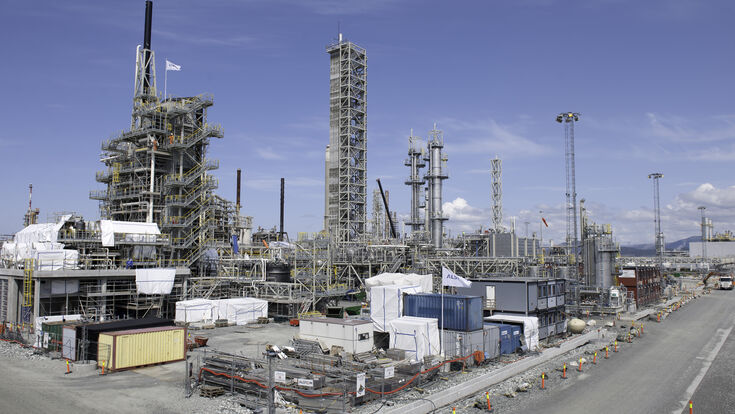Does Carbon Capture & Storage Have a Role in Waste to Energy : Waste to Energy Goes Carbon Negative in Norway

Active membership needed
Register now and become a WEKA PRIME member

- Rankings & analyzes from all industries
- All WEKA PRIME content of 12 online-magazines
- 1 E-Paper annual subscription of your choice
- E-Paper in your inbox a week earlier
With a good proportion of municipal waste comprising bio-derived materials, carbon capture and storage at waste to energy installations potentially offers carbon-negative waste disposal - and a big step forward on the route to the carbon-neutral cities of the future. Now, a waste to energy CCS plant on a scale to dwarf all previous attempts is the goal of Norwegian capital Oslo.
As a single source of city-wide carbon dioxide emissions, Oslo’s waste to energy facility is responsible for around 20% of the total. Incinerating the city’s waste, the installation is operated by municipally owned Klemetsrudanlegget Ltd.
Johnny Stuen, technical director of the Waste to Energy Agency for the City of Oslo, highlights the scale of the energy contribution from waste: “We exchange almost 1 TWh of energy in heating systems with energy from the waste treatment power plant, so that's a huge part of the energy supplied to the city. District heating delivers 20% of the city’s heating needs, and waste is 50% of that so approximately 10% of the energy supplied to the city is based on waste heat supplied through a district heating system.”
In the near future though, it may make a net negative contribution to the country’s carbon emissions. The plant is set to become one of three large-scale carbon capture, transportation and storage projects focusing on key high-emission sectors.
Emissions going negative on WtE
With a capacity of 310,000 tonnes of municipal waste per year, some 40 tonnes an hour, the Klemetsrud plant has been in operation since 1985. Under the current schedule, it is expected to become emissions negative in around 2022 with the addition of carbon capture and storage infrastructure that is expected to capture 90% of its CO2 emissions.
Carbon capture and storage at waste to energy plants in theory registers as carbon negative for overall greenhouse gas emissions as a significant proportion of municipal waste comes from organic, rather than fossil-fuel based, materials.
Bjørn-Erik Haugan, business development manager at the CCS research centre Technology Centre Mongstad (TCM), explains: “It can be perceived as a carbon-negative process since you are removing something that ultimately comes from the atmosphere, because a lot of the waste that you combust in a plant like that has some of some sort of bio source of the carbon. So I think it's very valid to look at treating emissions from these plants that are found worldwide.”
And as Stuen notes of Klemestrud: “The composition of the waste is 40% fossil carbon and 60% biogenic carbon.”
Discover now
- Reading
-
Videos
- Eldan at IFAT 2024 Dec 6, 2024
- Cesaro Mac Import and Tiger Depack at IFAT 2024 Dec 6, 2024
- Panizzolo at IFAT 2024 Dec 6, 2024
Pushing for feasible projects
In its October 2016 state budget, Norway’s Ministry of Petroleum and Energy set forward proposals to grant NOK360 million (US$43 million) of funding for the continued development of a full-scale carbon capture and storage demonstration facility. The development follows the July 2016 publication of a feasibility study showing that a CCS chain within a 2022 timeframe is possible.
Under the auspices of a programme administered by the state-owned company Gassnova SF, three industrial players completed studies on CO2 capture.
Along with the Klemetsrud waste recovery plant, Norcem AS, part of the Heidelberg Cement group, is considering CO2 capture from the flue gas at its cement factory in Brevik. Yara Norge AS, the world’s second-largest ammonia producer, are looking at capture from three different emissions points at its plant at Herøya in Porsgrunn.
Stuen points out some of the advantages of bringing forward three projects with shared infrastructure: “We were one out of three different companies that were asked to do a feasibility study. All of the three capture sites are placed around Oslo Fjord.” There is a long way between the plants, but they will share the infrastructure that you need to collectively transport the CO2 and the storage infrastructure.”
National gas transmission company Gassco has carried out a study of ship transport of CO2 between locations for capture and storage, while Statoil ASA has completed feasibility studies of CO2 storage at three different sites on the Norwegian continental shelf. Both Statoil and Gassnova consider the best solution to be the development of a CO2 storage site with onshore facilities and a pipeline to the Smeaheia area, east of the ‘Troll’ field and some 50 km from the coast.
As Stuen explains: “It's feasible, at all three sites it’s very feasible, you can capture at our site 90% of the CO2 from the plant, we can still deliver the same amount of heat to the city, but we have to use some electricity to be able to run the carbon capture plant.”
According to the study presented in July, the cost for developing a full CCS chain is estimated at NOK7.2-12.6 billion (US$865 million -$1.5 billion) depending on the number of plants built.
Gassnova has been project coordinator and is responsible for capture and storage, while Gassco AS is responsible for transport.
Interesting topic? Get more in-depth information on carbon capture here and here!
We are looking into solutions to make sure that we can deliver all the heat that we want to deliver to the city, even though we are running a capture plant.Johnny Stuen
Next steps
Based on the feasibility studies, concept studies will now go on until the autumn 2017 and continuation to a FEED (Front End Engineering and Design) phase will be considered in the 2018 budget, with a view to a potential investment decision on one or more projects within the summer of 2019. The government is expected to present further plans for CCS in the state budget for 2017.
In the meantime, the authorities will enter into contracts for the financing of concept studies with up to three capture projects.
Gassnova recently announced concept studies with an option for FEED, and Klemetsrud has already been working with potential technology suppliers. For example, in January 2016, as a part of the feasibility study Aker Solutions began a five-month test CCS programme to capture emissions from Klemetsrud, conducted using the company's mobile test unit. Aker Solutions has previously tested their technology for two years at Technology Centre Mongstad (TCM). The same goes for GE (formerly Alstom), another potential vendor.
In addition, the engineering consultancy firm Citec – which prepared the feasibility study for Klemetsrud - has been appointed to complete the engineering scope of integration and modification of the existing plant for CCS, as well as a number of key project management services in preparation for the next phase and the future full-scale development.
The planned start of this phase is set for March 2017, some services will, however, be initiated this year. As Stuen explains: “Moving to the concept and FEED stage, we are already preparing for it, discussing with different technical suppliers and so on, but the work itself will probably start in January.”
He adds: “We are talking to several capture suppliers for the moment, we think that it can be an amine or ammonia-based, but maybe also a drop-in chemical for amine, but it's going to be a chemical absorption solution. They are not very different from each other.”
Proven Technology Only
Stuen highlights the need for demonstrably proven CCS technologies among participants, saying: “All the suppliers that are bidding, they must have at least fulfilled a campaign at a test centre like Mongstad or some other test centre - there’s three or four in the world - to be able to participate in our completion.”
Indeed, in its latest budget statement the government has said that it will support continued operations at the TCM CCS research and test centre after the current agreement expires in August 2017. Initially funding will run for a further three years.
Says Haugan: “From TCM’s point of view, we’re looking at this project with great interest. I think it's a very commendable project. From the technology point of view, it's a bit of an uncharted territory in the sense that as far as we know, with the possible exception of Japan, we haven’t seen large-scale capture on flue gases from municipal solid waste combustion.” [See Box Out]
He continues: “When you have your technology evaluation, it's very important that you characterise very closely the nature of your emissions; what is the content of various concentrations in the flue gas? What are the fluctuations of the concentration as well as volume flow? And all of that has to be part of the specifications that the various technologies and vendors subject themselves to.”
Nonetheless, Stuen is confident in the CCS technology, but he does add the caveat: “Of course, we stressed to the suppliers that were in our feasibility study that they needed to have a much better energy balance in the process than they used to have, because our primary product is energy delivered to the city.”
Stuen concludes: “We are looking into solutions to make sure that we can deliver all the heat that we want to deliver to the city, even though we are running a capture plant.
“The suppliers must be able to deliver us an integrated carbon capture plant that can deliver as much energy to the city as we are doing today.”
What role does CCUS play in waste-to-energy? Read our interview here!
Building an economic case for CCS on WtE sites
With a budget of $43 million already on the table for the next phase, it is clear that the government expects to bankroll a substantial proportion of the final bill for developing large-scale CCS at Klemetsrud and elsewhere.
But while this government-backed venture will likely see these projects developed, Stuen emphasises the need for a long-term economic strategy for CCS from energy to waste plants: “All the industrial players are stressing the point that there must be value chain for the CO2 up and functioning when this project is operational in 2022. They must have a value chain that functions all the way from the capture to the transport to the storage and they must be very clear how it’s going to be paid for and who is going to pay for it.”
“That’s a work in progress,” he adds.
But he also sounds a note of optimism when it comes to waste to energy in a carbon constrained world. “Waste will always be there. I really don’t think we will have a zero waste community, we have to take things out of the cycle. If it’s too polluted or too dirty or if it has toxic things, then waste to energy is maybe one of the best final things than you can have, it’s much better than landfill. We will always have a waste to energy need or a waste incineration need in Europe and the rest of the world if we’re going to stop doing landfill.”
He adds: “I don’t think that carbon capture from landfill will be large, but I think carbon capture from waste to energy should be, maybe in 15 years’ time, the standard solution. Our hope for the world is that this is going to lay down a challenge for the industry.”
And, considering the ultimate aim of this giant CCS venture, Stuen observes: “If you look at power generation, carbon and oil will in one way or another disappear, there will be renewables, we’ll exchange energy production, but waste, cement and fertiliser, these are all processes we need to run to be able to live on this earth.”


